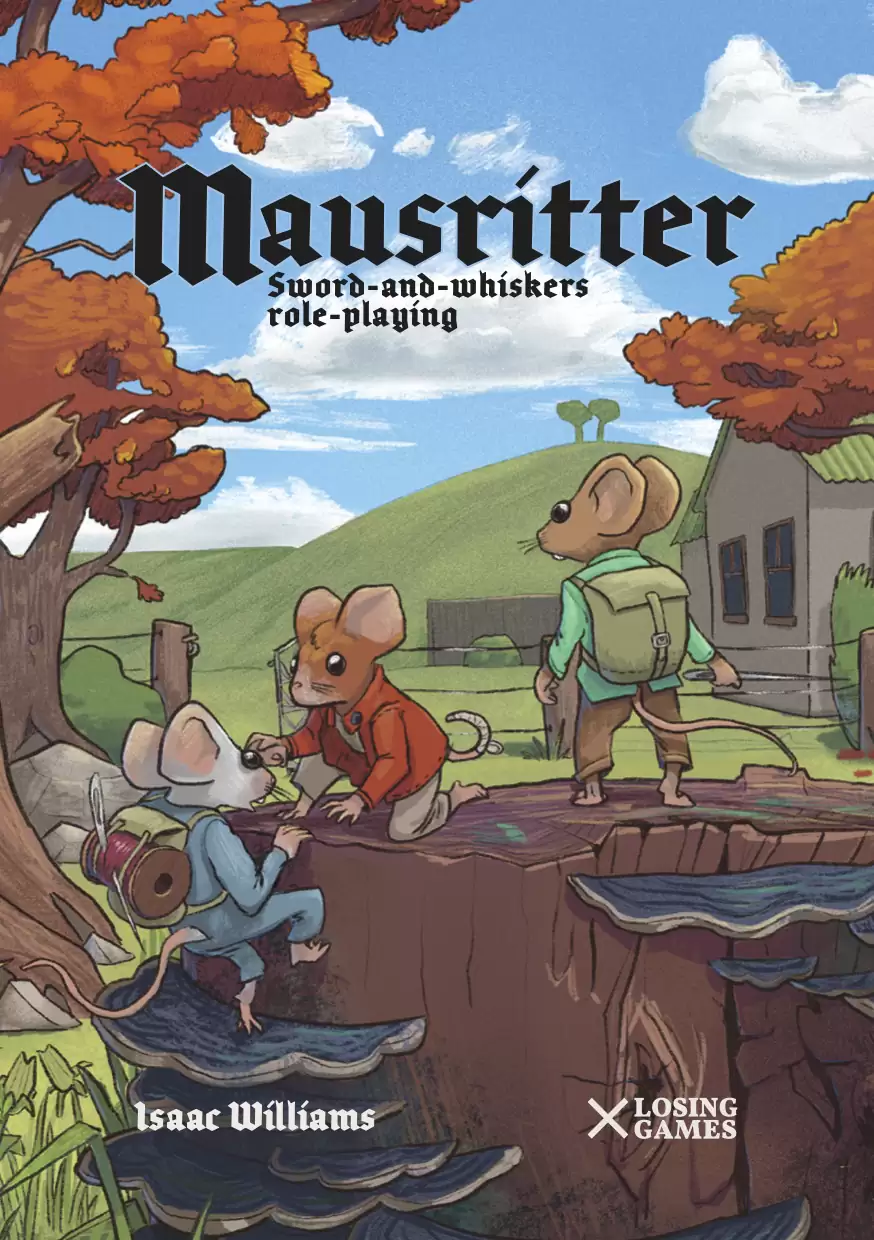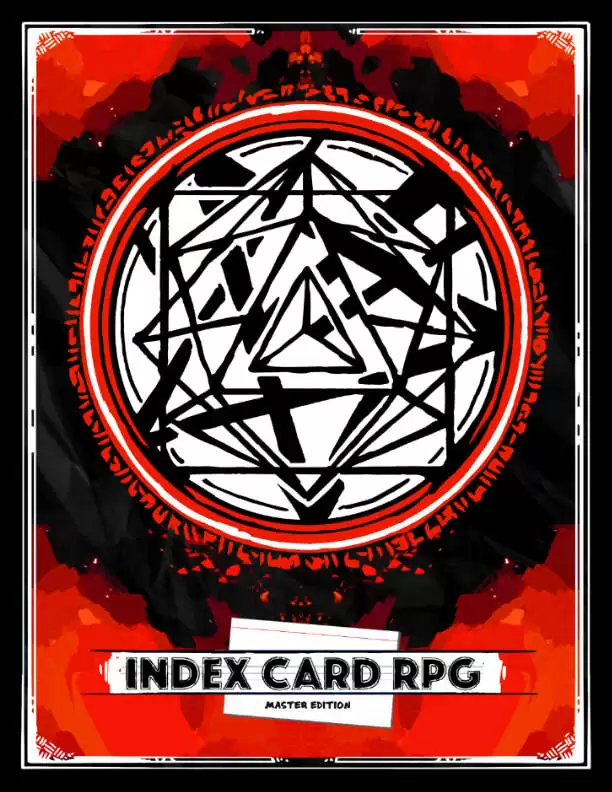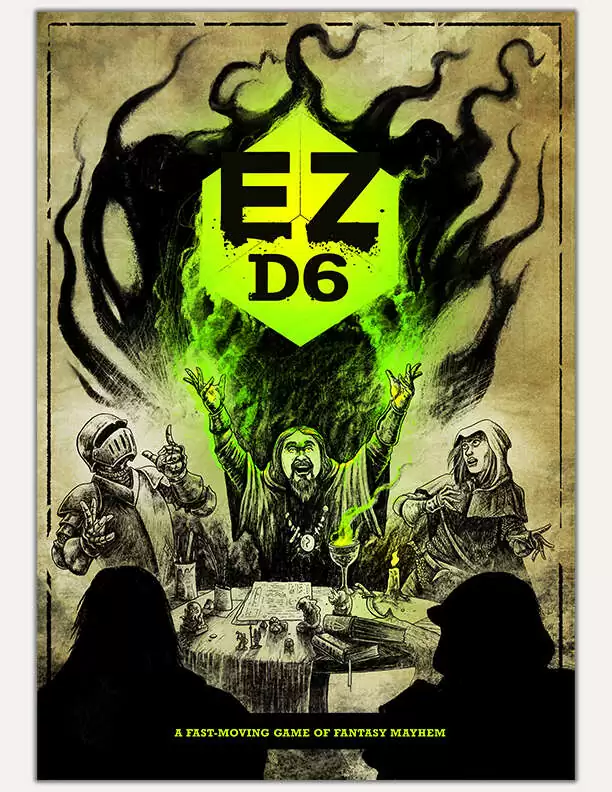What’s The Story, Muthur?
To the point, tabletop gaming
6 Games that nail What Rules-Lite TTRPGs Should Be
A good rules-lite system doesn’t overwhelm you with procedures and crunch for every situation. Instead, the key procedures are covered and it gives you a clear, concise core mechanic. Then it trusts you to apply it flexibly.
By JimmiWazEre
Opinionated Tabletop Gaming Chap
TL;DR - Rules-lite isn’t the same as rules-incomplete or rules-inconsistent. Don't conflate them.
This post contains affiliate links.
Introduction
I want more people to play Rules-Lite games, but this crusade of mine is hindered by a misconception of what a rules-lite game actually is.
A lot of people hear "rules-lite" and think "lazy" or "half-finished." But that’s missing the point entirely. A great rules-lite RPG isn’t undercooked, it’s efficient, elegant, and focused. Let’s unpack what makes a minimalist system actually good, and why "less" doesn’t mean "worse."
What Is Rules-Lite
A good rules-lite system doesn’t overwhelm you with procedures and crunch for every situation. Instead, the key procedures are covered and it gives you a clear, concise core mechanic. Then it trusts you to apply it flexibly.
It’s just like that old saying:
Give a GM a fish, and they can run a session. Teach a GM to fish, and they can run a campaign.
Or something like that. I don’t know, it's close enough.
What isn’t Rules-Lite?
Let’s be crystal clear, rules-lite is very different from rules that are simply incomplete or inconsistent.
Inconsistent rules happen when a mechanic is explained more than once but the explanations don’t match. This usually signals a rushed edit. One version may or may not have replaced the other, but both made it to print. That’s not planned ambiguity, rather it comes over as just poor proofreading.
Designers: please, if someone flags this, don't try to convince us that you’re providing options. No one's falling for it, just own it and issue a FAQ or errata.
Incomplete rules are when a mechanic is introduced but not fully defined. For example, a game might explain how to hit an enemy in great detail… but never actually explain how damage works. You can’t convince me that this is minimalist design, it's just frustratingly half baked rules - because now we know that there is a specific way that this should be done, but we’ve no idea what it is.
RAI Matters
It all comes down to understanding the Rules as Intended (RAI). If the designer has said enough to give the GM an understanding of the game’s core rules language, then the GM should be confident that they can make a ruling that falls in line with RAI. If not, flesh it out some more.
Gameplay examples are great for this, as are developer commentaries in the sidebar. Designers take note!
Experience matters
I'm a big fan of the rules-lite philosophy, but if you've never run a TTRPG before, there is a danger that you might not have developed that muscle yet which allows you to make rulings up on the spot that feel consistent with the game system. Just bear that in mind before you pick your first game.
That’s not to say that a rules'-lite game shouldn’t be your first, but rather that I just want to make sure that your expectations are managed. It may start difficult, but it will get easier as you go on.
Recommendations
If you’re interested in picking up a good rules-lite game, then I’ve got a short curated list for you of some of my personal favourites. Full disclosure though my dudes, some of these are affiliate links, and if you chose to pick one up using the links provided, then I’ll get a small kickback at no extra cost to you.
Mausritter

Mausritter is a charming, rules-lite fantasy RPG where players take on the roles of brave little mice in a big, dangerous world. Built on Into The Odd, an OSR style framework, it uses simple d20 roll under mechanics and item slots for inventory, making it quick to learn and run. Its elegance lies in its ability to deliver rich, old-school adventure vibes with modern usability and 1990’s Disney cartoon flair.
I played in a duette game of this with my wife at the kitchen table, and she really enjoyed the vibes. With tweaks to the lethality I can see this being really popular with young families too.
Index Card RPG

ICRPG strips tabletop roleplaying down to its essentials with fast, flexible rules that encourage creative problem-solving and dynamic pacing. Everything runs off a single target number per room or scene, making it intuitive and highly adaptable. Its modular design and DIY ethos make it perfect for GMs who like hacking and building custom worlds on the fly.
EZD6

Created by DM Scotty, EZD6 lives up to its name with a system that’s incredibly easy to pick up and play. Most rolls come down to a single d6 against a target number, streamlining gameplay while leaving plenty of room for dramatic moments. It’s especially good for narrative-driven groups who don’t wanted to be limited by predefined abilities on their character sheets, and instead want to freedom to narrate their abilities as they see fit.
One of my players who’d never GM’d before in her life ran a couple of us through a homebrew adventure using this system and it was an absolute blast.
Pirate Borg

Pirate Borg is a brutal, rules-lite game of swashbuckling horror on the high seas. Inspired by Mörk Borg, it mixes fast, deadly mechanics with punk rock layout and evocative setting material. It’s ideal for players who like their pirate adventures with a side of doom, decay, and dark magic, and who don’t mind their characters dying spectacularly.
The squint-and-it’s-historical side of this game has literally made me buy pirate history books and start listening to pirate podcasts. I love all that stuff now, and it takes me back to my childhood - playing Secret of Monkey Island on my big brother’s Amiga. Good times.
GOZR

GOZR is a wild, gonzo sci-fantasy RPG that feels like it escaped from the back of an '80s metal album cover. It runs on a straightforward d20 roll-over system and embraces weirdness at every turn, from its mutant characters to its DIY zine-style aesthetic. It's brilliant for groups who want something fresh, funky, and full of chaotic creativity without a ton of prep.
I also wrote an opinion piece for this game a few months ago which included a free system cheat sheet that I’d worked on with the help of the games designer to get players started sooner. Can’t recommend it enough!
Spellz!
Indie developer, Jake Holmes recently reached out to me on Bluesky with an interesting little one page rules-lite game he was working on called SPELLZ! The game is still in it’s beta testing phase and he’s taking feedback on it it, but for the price of totally free, and for the sake of reading less than a single page - it’s definitely worth a look in if you want to see just how lite the rules can go!

It’s a fast TTRPG where magic is improvised in real time using letter tiles. Players draw tiles and try to form words on the fly — the word they create becomes the spell, and its effect is narrated accordingly. Stronger or stranger words often have bigger effects, and failed spell attempts can backfire spectacularly, with the GM repurposing your discarded letters.
I’ve not played it, but I have given feedback on the rules which was promptly actioned. It looks quick, and perfect for creative groups who enjoy thinking on their feet, might even be a way to introduce TTRPGs to your mum, dad, and nan who’s idea of a tabletop game otherwise begins with crosswords and ends with Scrabble!
Heya, just a thought, if you want me to take a look at your game and feature it on the site, like SPELLZ! Then drop me a message, lets have a chat!
Conclusion
The key message here is that if you've been frustrated by rules-incomplete or rules-inconsistent in the past, please don't be put off a rules-lite system because you're assuming it's the same thing. It ain't. If you get overwhelmed by books the size of a university textbook and you want to start small, rules-lite could be for you.
And so endeth the sermon.
Hey, thanks for reading - you’re good people. If you’ve enjoyed this, it’d be great if you could share it on your socials - it really helps me out and costs you nothing! If you’re super into it and want to make sure you catch more of my content, subscribe to my free monthly Mailer of Many Things newsletter!
This post contains affiliate links.
I don’t know what to Run Next. I’ve got options. What do you Think?
My 5e Lost Mines of Phandelver campaign looks like it’s going to be drawing to a close in the next couple of months, I’ll have a write up of my thoughts on that module as and when.
But this has got me onto thinking about what to run next.
By JimmiWazEre
Opinionated Tabletop Gaming Chap
S’up?! - My 5e Lost Mines of Phandelver campaign looks like it’s going to be drawing to a close in the next couple of months, I’ll have a write up of my thoughts on that module as and when.
But this has got me onto thinking about what to run next. Deffo not D&D 5e, I’ve quite had my fill of that system for the time being thankyou!
So, I’ve narrowed it down to two campaign choices - which do you think I should go with?
Campaign Ideas
Shadowdark - Dungeons of Drakkenheim
I came across the Dungeon Dudes’ actual play series a few years ago, and I must confess that I found myself quite getting into it. I liked the grim dark setting and the player driven story style of the adventure - it has a very ‘Mordheim’ vibe about it which tickles my pickle.
The premise is that the city of Drakkenheim has been struck by a magical meteor and now lays in ruin. The residual magic has a mutating effect on the local fauna, creating new beasts and monsters of a Lovecraftian persuasion. However, ‘Delerium’ - the name given to the magical fragments of meteor left about the place, commands a high value in the market, and so there’s no shortage of intrepid adventurers and factions lining up to go a plundering the city ruins.
To cap it off, there’s a power struggle because the royal line has apparently been severed during the incident, with differing factions wanting to install new kings, or hunt down the existing royal family somewhere in the city. Lots of political intrigue to be getting on with.
So it sounds pretty cool, and when they released a campaign book for it (Dungeons of Drakkenheim), I figured it’d be rude not to pick it up!
Sadly, it’s designed for 5e, however now that I’ve got Shadowdark (which is built off 5e, but stripped of all it’s heavy baggage) and the recently completed Shadowdark Monster Conversion kit, I’m thinking that it probably wouldn’t be too difficult to convert the adventure over. Especially since the city of Drakkenheim is sort of a megadungeon, and Shadowdark seemingly seems to be a perfect match.
Mausritter - The Estate
I think I was introduced to Mausritter by Ben Milton over at Questing Beast a few years ago, and I was immediately charmed by it. So I picked up copies of both the core rules and “The Estate” which is a hex crawl sandbox adventure, featuring a dozen or so premade adventures for the different keyed location of the hex map.
The premise is that it’s the familiar D&D trope, except that you’re a mouse, and the world is full of mafioso cats, snakes, owls, rats, and other predatorial critters which essentially puts you at the bottom of the food chain. “The Estate” is a full hex crawl adventure that literally takes place in the property and grounds of a human’s stately home, some some adventures take place in the green house, others in the drainage system or chimney.
It’s built off the rules lite “Into the Odd” system, and aside from the low power level of the player characters, it’s main distinguishing features are that it is classless - your abilities are dictated by your current inventory. Also, you do not roll to hit, all hits are automatically successful, both ways, and it it’s just a question of how much damage.
It’s one of those games that’s been sat on my shelf for a while, having only played it the once with my Wife in a duette, so it’s definitely due it’s time in the sun.
I like it’s inventory system so much that I named it one of my favourite TTRPG mechanics, and built my own D&D house rule off the back of it!
Conclusion
Which gets your vote? Reach out in the comments below and let me know!
Hey, thanks for reading - you’re good people. If you’ve enjoyed reading this, it’d be great if you could share it on your socials, and maybe think about subscribing to the Mailer of Many Things! Either way, catch you later.
the pip system is the best inventory management solution for your RPG
One of the three key pillars of D&D is exploration, and inventory is a major part of what makes exploration interesting and consequential, it creates a good problem for players to try and solve.
…In my opinion
The Pip System as I use it is broadly lifted from Mausritter by Isaac Williams, which is a brilliant little D&D adjacent fantasy RPG starring mice as heroes against the evil forces of Rats, Frogs and Cats. Check it out, it’s won awards and stuff!
pip system Setup
By default, each player character should have ten item slots. You can easily just represent this as empty rows on a list. If the player buys a better bag for their character, give them 15 item slots instead.
On the right hand side of each row, you should have three empty circles drawn in pen, known as “pips”. Players mark or rub out the insides of the pips with a pencil to represent the abstract quantity or quality of the given item.
This way, each row will contain an item with 1, 2, 3, or 0 pips filled in. These amounts of pips can represent abstract quantities and qualities.
The more pips are marked, the better the situation is.
How to use the Pip System
Consumable items can stack, so that one item slot might carry multiple arrows, rations, spell components, or whatever. However the amount of things in the stack is abstracted to either lots, plenty, a few, or none, according to its pips. Never fall into the trap of allowing your players to place an actual granular value against an item as it undermines the system.
In otherwise exactly the same abstract way, non-consumable items don’t stack, but they can deteriorate, like swords or armour getting damaged with use. So such an item might be in perfect, good, bad, or destroyed condition represented accordingly by its pips.
The key message is that the quantity or quality of the item in the stack is represented by how many adjacent pips are filled in.
Depreciation
After a battle, for any item that saw some use during the battle, roll a d6, on a result of 1-3 reduce the pips of that item by 1. This is called “rolling for depreciation”.
Outside of battle, anytime someone uses an item on a per use basis, roll for depreciation again.
In this way, player characters will find their swords starting to chip, their shields breaking with overuse, and their arrow and potion supply dwindling.
Restocking
Whenever players loot a body, they might find armour, weapons, potions, whatever. But these looted items should always be one pips worth to represent their scavenged quality.
If players buy the items from a shop, or find them in chests etc, then the items should be three pips worth.
Likewise, players can take their swords and armour to a blacksmith and have them repaired (pip restoration) for a fee.
Use my Pip System Tracker
You absolutely can (and probably should) very easily make up your own inventory sheets for this system, but if you want to support this blog, please sign up to the free Mailer of Many Things, and you’ll be given a link to my exclusive premade A5 pip inventory sheet, as well as receiving occasional news round ups from this site and the broader tabletop news ecosystem.
You’ll notice the additional sections for currency and pocket items on my inventory sheet - I basically allow for infinite coins to be carried, and as many tiny items as your player can justify fitting in their characters pockets.
For most forms of treasure that players are likely to encounter on their adventures, I like to apply some abstraction and stack them together under “valuables” on the main sheet, the pips in this instance indicate the value of your row of valuables. Once a row of valuables hits three pips, if you pick up some more, it’s time for a new item row of valuables! Players won’t know exactly how much a given row of valuables is until they sell it at a shop for currency, and that can be up to the GMs discretion.
This way, for most types of treasure that players encounter, they will still need to weigh up if it’s worth using up an item slot for.
Why Use the pip System?
You might have noticed that I gave away the juice immediately with this blog post, but for anyone who’s interested in the reasoning and theory, read on, dear reader!
Granular Inventory Systems Slow Everything Down
Contemporary official D&D suffers from a really bad inventory system, it asks players to continually be adding and subtracting literal weights of items using the near globally rejected Imperial System of measurement.

Using granular weights and measurements to track inventories further places burden on the DM to either invent an appropriate weight for things on a per item basis, or it asks them to stop the game and look up a list somewhere to get the weight of something.
This is painful, and unless you have a kink for accounting, I can’t imagine anyone ever sticking with it in favour of following the conventional wisdom of just hand-waving the system altogether and playing by “feels”.
Hand-Waving Inventory Systems Can Undermine the Game
One of the three key pillars of D&D is exploration, and inventory is a major part of what makes exploration interesting and consequential, it creates a good problem for players to try and solve. Intrepid explorers should be asking:
Do I have the right equipment for the job?
Do I have enough food and water to keep going?
Is my torch going to last?
Is my gear going to last?
Have I got enough arrows?
How much should I sacrifice to be able to carry away more loot?
In addition to this, without good inventory management you have no consistent system to track the deterioration and consumption of your stuff. The logical conclusion from this is that you’ll never need to spend your loot to replace said stuff.
Now your game economy is ruined, players can just collect infinite amounts of gold without needing to spend any meaningful amounts of it, which begs the question; What is the motivation to go on adventures to collect more?
Game designers have tried to answer this by inventing subsystems of varying complexity for buying keeps and businesses as a way to try and get you to spend. It’s like they casually forgot that D&D is about running around having heroic adventures, not managing your property portfolio!
I jest of course, people do actually enjoy the power fantasy of having their dudes owning a keep or similar in D&D and that’s all well and good*, so I guess the point I’m trying to make is that the game shouldn’t have to rely upon this in order to have a game-functional economy.
conclusion
So that’s it, in the Venn-diagram of granular and abstract inventory management systems for TTRPGs, the Pip System sits nicely in the middle, occupying a best of both worlds position which supports players making interesting and impactful choices without forcing anyone to perform boring accounting tasks.
Hey, thanks for reading - you’re good people. If you’ve enjoyed reading this, it’d be great if you could share it on your socials, and maybe think about subscribing to the Mailer of Many Things! Either way, catch you later.
*My own D&D character, Mendagg, is a Dwarf cleric-come-chef who wants above all else to own a pirate ship that he can convert into a floating restaurant. It’s gonna have a mahoosive shark jaw above the entrance and it will serve the finest dishes from across the land - he’s even been collecting recipes on his adventures.
















Tactics don’t carry over, and that’s for the best. I didn’t want a reskinned Nemesis. I wanted something that pushes you into new patterns of play, and the game delivers.